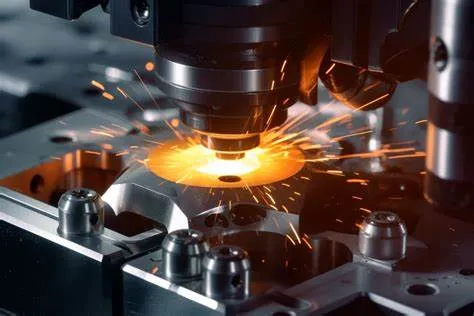The Role of Machining Manufacturers in Global Supply Chains
Global supply chains rely heavily on machining manufacturers to deliver precision, scalability, and innovation. From automotive to aerospace, these manufacturers ensure components meet rigorous standards while adapting to evolving technologies like abrasive water jet machining and additive machining. By integrating diverse machining types, they serve as backbone partners for industries requiring bulk production of complex parts. This article explores how these players drive efficiency, reduce costs, and enable large-scale operations worldwide.
Integrating Diverse Machining Types for Bulk Production Efficiency
Machining manufacturers leverage a spectrum of machining types—such as CNC milling, turning, and EDM—to optimize bulk production. For instance, high-speed CNC systems enable rapid fabrication of thousands of identical parts, while abrasive water jet machining cuts thick or heat-sensitive materials without compromising structural integrity. This versatility ensures manufacturers meet demands for everything from automotive engine components to industrial machinery parts. By combining traditional methods with advanced processes like additive machining, they reduce material waste and shorten lead times, critical for wholesale buyers prioritizing cost and speed.
For aerospace clients, aerospace machining suppliers often employ hybrid approaches, pairing 5-axis milling with abrasive water jet machining to produce lightweight, high-strength components. Such adaptability allows manufacturers to scale operations while maintaining tight tolerances, ensuring seamless integration into global supply chains.
Aerospace Machining Suppliers: Delivering Precision at Scale
Aerospace machining suppliers specialize in producing mission-critical components like turbine blades and structural brackets, often requiring advanced machining types such as electrochemical machining (ECM) or laser drilling. These suppliers prioritize certifications like AS9100 to guarantee compliance with aerospace standards, ensuring reliability for bulk orders. Technologies like abrasive water jet machining are particularly valuable for cutting composites and titanium alloys, minimizing delamination and heat distortion.
Additionally, additive machining is revolutionizing aerospace production by enabling complex geometries that reduce part weight and assembly steps. Suppliers using powder-bed fusion or directed energy deposition can now manufacture fuel nozzles or brackets in bulk, aligning with the industry’s shift toward lightweight, fuel-efficient designs. By integrating these methods, aerospace machining suppliers streamline workflows and reduce costs for wholesale buyers.
Abrasive Water Jet Machining: Cost-Effective Bulk Material Processing
Abrasive water jet machining has become indispensable for machining manufacturers handling bulk orders of thick metals, ceramics, or composites. Unlike thermal cutting methods, it produces no heat-affected zones, preserving material properties—a key advantage for industries like energy or construction. For example, manufacturers use this technology to cut turbine components or architectural steel panels in large volumes, ensuring consistency across batches.
Wholesale buyers benefit from reduced secondary processing costs, as water jet systems often deliver near-net-shape parts. When paired with additive machining for prototyping or hybrid manufacturing, manufacturers further optimize material usage and turnaround times. This synergy is critical for sectors requiring high-volume output without sacrificing precision.
Additive Machining: Revolutionizing High-Volume Customization
Additive machining is transforming bulk production by enabling mass customization without traditional tooling constraints. Machining manufacturers use metal 3D printing to produce jigs, fixtures, and end-use parts in large quantities, ideal for automotive or medical industries. For aerospace machining suppliers, this technology supports rapid iteration of prototypes and lightweight components like brackets or heat exchangers.
By integrating additive machining with subtractive processes, manufacturers achieve tighter tolerances and smoother finishes, meeting wholesale demands for both complexity and scale. For example, hybrid systems can 3D-print a near-complete part and finish it with CNC milling, reducing material waste. This approach is reshaping supply chains, allowing faster responses to market shifts.
FAQs: Addressing Key Concerns for Wholesale Buyers
How do machining manufacturers ensure quality in bulk orders?
Reputable machining manufacturers adhere to ISO certifications and employ statistical process control (SPC) to monitor production consistency. Advanced metrology tools like CMMs validate part dimensions across large batches.
What materials can abrasive water jet machining handle for bulk projects?
Abrasive water jet machining cuts metals (steel, titanium), composites, stone, and ceramics, making it ideal for diverse industries requiring thick or layered materials.
Why choose additive machining for high-volume production?
Additive machining reduces tooling costs and enables complex designs unachievable with traditional methods. It’s scalable for batches ranging from hundreds to thousands of units.
How do aerospace machining suppliers manage lead times for bulk orders?
Suppliers use predictive maintenance, multi-shift operations, and digital twin simulations to optimize equipment uptime and meet tight deadlines.
Can abrasive water jet and additive machining be combined?
Yes. Hybrid systems use additive machining to build near-net shapes and abrasive water jet machining for precision finishing, ideal for high-value components.
-
Types of Pressure Die CastingNewsMay.30,2025
-
Precision Casting Manufacturers for High-Quality Metal ComponentsNewsMay.30,2025
-
Key Steps in Aluminum Die Casting ManufacturingNewsMay.30,2025
-
How to Find Affordable Die Casting Components for SaleNewsMay.30,2025
-
General Topics on Casting & Die CastingNewsMay.30,2025
-
Discuss Leading Manufacturers SpecializingNewsMay.30,2025
















